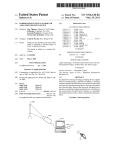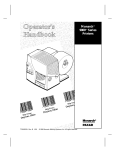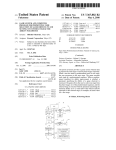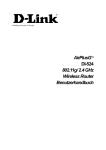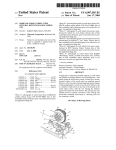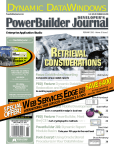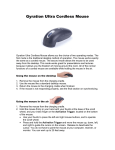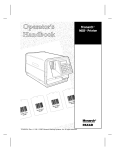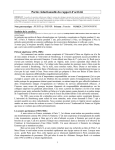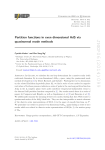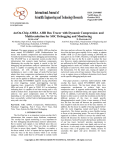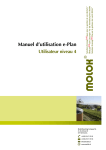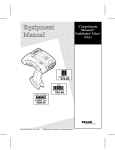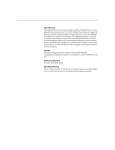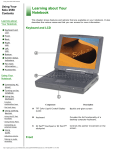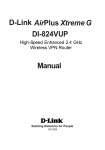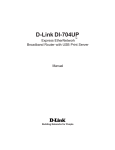Download Hybrid presentation controller and computer input device
Transcript
US007061468B2 (12) (54) United States Patent (10) Patent N0.: Tiphane et al. (45) Date of Patent: HYBRID PRESENTATION CONTROLLER AND COMPUTER INPUT DEVICE 5,578,817 A 5,617,304 A (75) Inventors: Guy Tiphane, Atherton, CA (US); Jan 9/1997 Knowles et al. 10/1997 Bl‘llvllle et 31' i (73) Assignee: Logitech Europe S.A. (CH) (*) Notice: i gslung 0/1997 Bili?g'iigne et a1‘ 5,729,009 A 3/1998 Dindliker et 31‘ 5,786,804 A 7/1998 G d 5,791,766 A Subject to any disclaimer, the term of this patent is extended or adjusted under 35 11/1996 Bidiville et 211. 4/1997 Huang 5,663,828 A 537033356 A Florian Max Kehlstadt, Aclens (CH) 8/1998 L2; on 5,793,032 A 8/1998 Bard et al. 5,803,582 A 9/1998 Hunag U.S.C. 154(b) by 254 days. (Continued) (21) Appl. N0.: 10/117,436 . (22) F1led: FOREIGN PATENT DOCUMENTS DE Apr. 4, 2002 (65) 298 23 417 Prior Publication Data Us 2003/0028688 A1 OTHER PUBLICATIONS _ Interactive RF Remote Control for PresentationsiUser’s Related U‘s‘ Apphcatlon Data (60) Provisional application No. 60/283,109, ?led on Apr. 10, 2001. (51) I t Cl . 5/1999 (Continued) Feb. 6, 2003 _ n Jun. 13, 2006 5,680,157 A Edbrooke, Cupertino, CA (US); Laurent Plancherel, Lausanne (CH); US 7,061,468 B2 Guide, version 1.6, 1998, and data sheet, 1999, Interlink Electronics, 1110-, Camarillo, CA, USA (Continued) Primary ExamineriAlexander Eisen . (52) US. Cl. ..................................... .. 345/158; 345/166 (7:)C‘4mr’fg1P/1gem1 0r Fi””*T°WnSend and Townsend (58) Field Of Classi?cation Search ...... .. an 345/156467, 345/818 ’ 833 ’ 830 See application ?le for complete search history. (56) An input device having a housing; a pointing device coupled With the housing having a plurality of buttons; a scrolling element coupled With the housing; and a module for detect ing user input for operating the input device in at least a ?rst mode and a second mode, Where in the ?rst mode, the input device operates as a tabletop computer pointing device, and U.S. PATENT DOCUMENTS 4,794,384 4,799,055 5,288,993 5,420,943 5,453,758 5,457,478 5,481,265 A A A A A A A 6/1985 Lyon 6/1985 Lyon 12/1988 1/1989 2/1994 5/1995 9/1995 10/1995 1/1996 ABSTRACT ( ) References Cited 4,521,772 A 4,521,773 A few 57 Jackson Nestler et al. Bidiville et a1. Mak Sato Frank Russell Where in the second mode, the input device operates as a hand-held presentation device used to control a computer based presentation. 17 Claims, 2 Drawing Sheets 22o \ \ \ \ \ \ \ \ \ \ \\ \ \\ \ 216 ‘ I: 214 E 212 US 7,061,468 B2 Page 2 WO US. PATENT DOCUMENTS 5,838,639 5,854,482 5,854,621 5,881,366 5,882,106 5,907,152 5,952,997 5,988,832 5,993,026 5,994,710 6,002,427 6,012,229 6,014,132 6,022,126 6,057,540 6,070,992 6,081,261 6,084,574 6,097,371 6,132,064 6,133,907 6,145,746 6,151,015 6,157,591 6,175,357 6,181,329 6,195,093 6,281,882 6,342,878 6,414,700 6,417,840 6,424,335 6,515,651 6,525,306 6,532,152 6,545,643 > 11/1998 12/1998 12/1998 3/1999 3/1999 5/1999 9/1999 11/1999 11/1999 11/1999 12/1999 1/2000 1/2000 2/2000 5/2000 6/2000 6/2000 7/2000 8/2000 10/2000 10/2000 11/2000 11/2000 12/2000 1/2001 1/2001 2/2001 8/2001 1/2002 7/2002 7/2002 7/2002 2/2003 2/2003 3/2003 4/2003 HWang Bidiville et a1. Junod et a1. Bodenmann et al. Galli Déindliker et al. Hu Chen Wu Knee et al. 8/1998 8/1999 WO WO WO 6/2000 6/2000 2/2002 PCT- WO 00/33245 PCT- WO 00/38103 PCT- WO 02/11058 A2 OTHER PUBLICATIONS Logitech TrackMan Live, [online], [retrieved on Dec. 5, 2002]. Retrieved from the Internet: <URL: http://WWW. 001abc.com/mouse/Logitechitrackmanilive.html. FreePen® On-line [online]. Kanitech, 1999 [retrieved on Kipust Oct. 29, 1999]. Retrieved from the Internet: <URL: WWW. Shiao Shimada et a1. Sekine et al. Gordon et al. Schnell freepen.com/index2.htm>. GyroMouse Pro [online]. Diamond Multimedia Systems, Inc., 1998/1999 [retrieved on Oct. 29, 1999]. Retrieved from the Internet: <URL: WWW.diamondmm.com/products/cur rent/gyromouse.cfm>. Bidiville Siddiqui et al. .......... .. 345/164 Bear Liu Bard et al. Badyal et al. 1 page; Retrieved from the Internet <URL:WWW.jdjstore. com/logtraclivco.html>. Chevassus et a1. ....... .. 345/158 Kurtenbach et al. ...... .. 345/810 Daniels Kim et al. Berstis ..................... .. 345/157 250/221 White et a1. .............. .. 361/692 10/1997 6/1998 6/1998 5/1991 11/1997 JD] Store Catalog Page; [retrieved on Apr. 6, 2001] 2 pages; Retrieved from the Internet: <URL:WWW.jdjstore.com/ keyboardsmice.html>. NetWorking For All, Marco PoZZoni; Apr. 4, 2001; [retrieved Bohn SWard et al. FreePen Cordless Computer Mouse User Manual, Kanitech A/S, pp. 4-14, 1999. TrackMan® LivelTM; [retrieved on Apr. 6, 2001]. 1 page; Retrieved from the Internet: <URL:WWW.Logitech.com/cf/ products/productfeatures .cfm/ 14>. Logitech TrackMan Live! Cordless Presentation, Copyright © 2001 Sys-Con Publications, [Retrieved on Apr. 6, 2001] Krantz Gordon Stork et al. Nelson et al. Gordon et al. ............. .. 343/702 FOREIGN PATENT DOCUMENTS 0 798 659 10171596 A 10171597 A WO 91/07826 W0 97 41502 PCT-WO 98/37379 WO PCT - WO 99/39304 on Apr. 6, 2001] 1 page; Retrieved from the Internet: <URL:WWW.cimpa.org/ichat1/000000I0.htm>. Agilent Technologies, “Solid-State Optical Mouse Sensor With PS/2 and Quadrature Outputs,” Technical Data, May 2000, 10 pages. Hinckley, Ken and Sinclair, Mike, “Touch-Sensing Input Deveices,” Microsoft Research (To appear in ACM CHI’99 Conf. On Human Factors in Computing Systems), 1999, 8-pages. * cited by examiner U.S. Patent Jun. 13, 2006 Sheet 1 6f2 US 7,061,468 B2 U.S. Patent Jun. 13, 2006 Sheet 2 6f 2 US 7,061,468 B2 214212f. (210 216 FIG.2 US 7,061,468 B2 1 2 HYBRID PRESENTATION CONTROLLER AND COMPUTER INPUT DEVICE the input device in at least a ?rst mode and a second mode, Where in the ?rst mode, the input device operates as a CROSS-REFERENCE TO RELATED APPLICATION mode, the input device operates as a hand-held presentation device used to control a computer-based presentation. In certain embodiments, the pointing device is a computer tabletop computer pointing device, and Where in the second This application claims the bene?t of US. Provisional mouse and the scrolling element is a Wheel, a force-sensitive roller, a solid state roller, a trackball, a mini joystick, a touchpad, or combinations thereof. Application No. 60/283,109, ?led Apr. 10, 2001, the disclo sure of Which is incorporated herein by reference in its entirety for all purposes. In certain embodiments, the input device While in the second or presentation mode uses one of the plurality of buttons to move the computer-based presentation in one direction, and another of the plurality of buttons to move the BACKGROUND OF THE INVENTION The present invention relates to computer input devices, computer-based presentation in another direction. For and in particular to computer input devices used for con example, the left button is used to move one slide forWard and the right button is used to move one slide backWard in trolling a computer-based presentation. The use of desktop and portable or notebook computers is steadily on the rise, and along With this rise there is also a rise in the use of such computers for the preparation and presentation of computer-based presentations. Furthermore, a computer-based presentation. 20 along With the increase in the use of computers, there has also been an increase in the use of input devices, such as computer mice, trackballs, and other pointing devices, including joysticks, gamepads, etc. These various computer input devices greatly enhance the operator’s usability of the 25 computer beyond that of a user having only a keyboard. On another front, the use of various projection-based presentation devices has also been on the rise. Such devices 30 In some embodiments, the input device is a Wireless device that communicates With a host computer via a Wireless receiver that is connected With the host computer 35 via a communication bus. In another aspect, the input device also includes a laser pointing device that is coupled With the housing. Apresenter generally Wishes to, or needs to be in front of his or her audience While making the presentation, and does not Want to be back near his or her computer to control the ogniZe a sWitch betWeen the ?rst mode and the second mode, and treat user inputs initiated in the ?rst mode and the second mode for processing by a computer Which is con nected With the computer input device. puter and the person presenting needs to have access to his or her computer to maneuver through the computer-based presentation. HoWever, the person presenting does not Wish to hinder the effectiveness of the presentation by not being in front of his or her audience When making the presentation. sWitch places the input device in the second mode, and a third activation of the sWitch turns the input device off. In an embodiment, the module for detecting user input for operating the input device in at least a ?rst mode and a second mode includes a softWare driver con?gured to rec When interfaced With a computer, enable a user to project his or her computer-based presentation onto, for example, a large screen for vieWing by an audience. The problem is that the computer-based presentation is driven from the com In one embodiment, the module for detecting user input for operating the input device in at least a ?rst mode and a second mode includes a three-Way sWitch coupled With the housing, Wherein a ?rst activation of the sWitch places the input device in the ?rst mode, a second activation of the 40 presentation by using the computer’s input device. Further For further understanding of the nature and advantages of the present invention, reference should be made to the folloWing description taken in conjunction With the accom panying draWings. more, most presentations to a large audience are conducted in a loW light condition, such as in a room With the lights BRIEF DESCRIPTION OF THE DRAWINGS turned doWn. So besides being required to be near the computer input device, and thus practically invisible to his 45 FIG. 1A is a top perspective vieW of one embodiment of or her audience, the person presenting Will have to maneuver the hybrid presentation controller and computer input device the computer input device in the dark. To address this problem, some projection-based presen of the present invention. FIG. 1B is a bottom perspective vieW of the hybrid tation device manufacturers offer a presentation controller that if properly interfaced With a computer Would alloW an presentation controller and computer input device of FIG. 50 operator to control the computer-based presentation by using 1A. FIG. 2 is a diagram of an embodiment of the hybrid the presentation controller. Suf?ce it to say that establishing presentation controller and computer input device of the such a proper interface betWeen the presentation controller and the computer is no less than a Herculean task. Further more, most presentation controllers use very non-intuitive present invention connected With a computer. 55 and confusing interfaces that only complicate their cumber DETAILED DESCRIPTION OF THE INVENTION some and unruly assortment of buttons and sWitches. Embodiments of the present invention combine features There is therefore an unmet need for a convenient pre sentation controller that also is able to function as a com puter input device. 60 BRIEF SUMMARY OF THE INVENTION PointTM). Such a computer-based presentation is typically The present invention provides an input device having a housing; a pointing device coupled With the housing having a plurality of buttons; a scrolling element coupled With the housing; and a module for detecting user input for operating of an input device or a pointing device (eg a computer mouse) With a presentation controller. As used herein, a presentation controller is an interaction device that is used to control a computer-based presentation (e.g., a device used to control an application program such as Microsoft PoWer 65 provided during a technical conference or a marketing seminar. Further, as used herein, a computer mouse accord ing to embodiments of the present invention includes a US 7,061,468 B2 3 4 multi-button computer mouse having a scrolling element. The scrolling element includes a Wheel, a trackball, pressure devices, and some have even combined laser pointers With other devices such as Watches, pens, range ?nders and sensitive sWitches or solid state rollers that are con?gured to enable a scrolling function. The scrolling element in such a ?rearm targeting devices. The incorporation of a laser pointer With a presentation controller adds convenience in computer mouse typically combines the operations Which that the laser pointer has utility during a presentation, since are normally carried out by a middle button of a three button the operator can use such a presentation controller to control mouse (i.e. by being clickable) With the operations that are the presentation and use the laser pointer to point to sections Well-suited to the scrolling function of a mouse-Wheel, as is knoWn in the art. of relevant screens, Without needing to carry both a presen tation controller and a laser pointer device. Further, a laser pointer that is coupled With a presentation device as is done Preferably, the hybrid device of the present invention operates in at least tWo modes. In a ?rst or mouse mode, or in embodiments of the present invention, is easily actuated tabletop mode, the device functions as a usual computer input device (eg a computer mouse), Which is placed on a ?at surface to input position-based information to a host by a button click of the device 110. The button used to activate the laser pointer 120 is any of the multiple mouse buttons 112. Altemately a dedicated button is used on the device 110 for the actuation of the laser pointer 120. computer. In a second or presentation mode, or a hand-held mode the A three position on/o? sWitch 118 shoWn in FIG. 1B, is device is lifted from the tabletop and carried by its operator to control a computer-based presentation by clicking any of placed on the underside of the device 110 to turn the device the device’s buttons to move forWard or backWard in the electronic slide presentation. FIG. 1A shoWs an embodiment of the hybrid presentation controller and computer input device 110 of the present invention. The device 110 has tWo buttons 112. One button, for example, the left button operates as “forward” and the other, for example, the right one operates as “backward” 20 second button activation places the device in the presenta tion mode; and a third activation turns the device 110 o?“. In an embodiment, When the device is in the presentation mode, the laser pointer 120 is enabled, and When the device 25 While in a computer-based presentation (e.g. Microsoft PoWerPointTM), When the device is in the presentation mode. For example, the clicking of one of the buttons is con?gured to advance the presentation forWard by one slide frame, While the clicking of another mouse button is con?gured to on and use it in either the presentation mode or the mouse mode. In one embodiment, a ?rst activation of the button 118 turns the device on and places it in the mouse mode; a is in a mouse mode, the laser pointer is disabled. Certain embodiments of the device 110 include status LEDs 114, such as, for example, tWo red/green colored LEDs that are visible via WindoWs in the top cover of the device 110, in front of buttons 112. In a Wireless device move the presentation one slide frame backWard, in the same embodiment, the LEDs indicate battery poWer level and Wireless connectivity. For battery poWer level, in an embodi Way that using the “page doWn” and “page up” buttons on ment, the green light Will shine for, for example, 5 seconds a computer keyboard cause a forWard and a backWard movement Within an electronic slide document. battery level is good. If the battery level gets loW (e.g. less In the mouse mode, the buttons act as they do in a typical mouse, Where the left button acts as the “click/select” button and the right button acts as the “alt select” button. In both the 30 When the device is sWitched on and then go o?“, When the 35 Then, if the battery is exceptionally loW (e.g. less than 5% mouse and the presentation mode the button functionality is changeable via a device setup softWare program that may be installed on a computer during the initial installation of the device. The device 110 also has a scrolling element 116. Various embodiments of the scrolling element 116, include a track ball, mini joystick, a touchpad, a Wheel, a solid state roller (“SSR”), or a force sensitive resistor. The functionality of the force-sensitive resistor that is implemented in a pointing device is described in a co-pending U.S. patent application 40 For Wireless connectivity, the connectivity LED ?ashes, for example, once every second until the connection is made and then the green LED is on for, for example, 5 seconds, 45 second until the user moves back in range. While connec tivity is maintained, the connectivity LED ?ashes, for 50 entirety. In an embodiment that includes a solid state roller (SSR), scrolling is achieved by placement of a ?nger on metallic sensor(s), one pair at the front of the SSR to indicate modes using the three-Way on/o? sWitch 118, the sWitching is enabled automatically. An automatic sWitching from a ?rst mode (e.g. pointing device mode) to a second mode (e.g. presentation mode) occurs When the device is lifted from the tabletop. The device is con?gured to recogniZe that it has 60 been lifted from the tabletop using mechanical means for a mechanical (eg a ball-type mouse) mouse. Altemately, the device 110 is con?gured to recogniZe that it has been lifted from the tabletop using optical means for an optical mouse. pointer 120 that is coupled With the device 110, as is shoWn in FIG. 1B. The laser pointer 120 may be con?gured to be Mechanical means, for example, include a sWitch that is activated in response to a mouse button click. Moreover, the laser pointer 120 may only be activatable When the device 120 is being operated in its hand-held or presentation mode. Laser pointers have become more popular as pointing example, green every 30 seconds and When the user hits any of the buttons. A recessed connect button is placed on the bottom-side of the device 110 to enable the connection of a device 110 to its receiver, at least for the very ?rst time the device is used. Altemately, in addition to the sWitching betWeen the tWo 55 ratchet” and the continuous pressing of the SSR is equiva lent to a “continuous scroll.” The scrolling element 116 is placed on the top side of the device 110 to alloW a user to have scroll capabilities in the mouse as Well as the presen tation modes. Alternate embodiments of the device 110 include a laser and then o?. If the user starts to move out of the range of the device’s receiver, the LED ?ashes, for example, red once a Sensitive Resistor,” assigned to the assignee herein, the a “scroll up” and one pair at the rear of the SSR to indicate “scroll doWn.” One press of the SSR is equivalent to a “roller of usage left), the LED Will remain a constant red. If during use, the battery level goes from an acceptable level to a loW level, the LED starts to ?ash red at rate of, for example, once every 5 seconds to Warn the user that the battery is loW. Ser. No. 10/010,072, entitled: “Pointing Device With Force disclosure of Which is incorporated herein by reference in its than 50 hours or 20% of typical usage left), the LED Will ?ash red, at a rate of, for example, once per 10 seconds. 65 biased against the top of the ball, and is con?gured to detect When the ball drops loWer, for example, as in When the mouse is lifted from the table-top. Optical means, for US 7,061,468 B2 6 5 example, include using optical detectors to sense a change in the intensity of the detected light to indicate that very little These and other examples of most needed shortcuts for the device are loaded or preprogrammed into the scroll element menu before the device is used during a presenta re?ected light is hitting the optical detector, as in, for example, When the optical mouse is lifted from the tabletop. Furthermore, the optical detector is con?gured to detect the tion in its hand-held mode. Having preprogrammed the difference betWeen a fast change in light intensity, as in or her hand and Walk around during the presentation, sWitch scroll element menu, the operator can hold the device in his When the mouse is lifted from the table-top from the more ing slides and/or selecting preloaded functions easily by gradual case, Where the battery poWer level has been depleted. The optical mouse embodiment houses an Agilent using the scroll element of the device. As shoWn in FIG. 2, the device 110 communicates With a host computer 210 (e.g., to control an electronic slide shoW application program) via a Wired connection or alternately optical module, including an Agilent optical sensor. Altemately, a manual sWitching betWeen a tabletop mode and a handheld mode is achieved by indicating to the device through a softWare program, Which invokes a setup program, to recogniZe button and scroll functions corresponding to either a tabletop computer mouse mode or a handheld 15 presentation device mode. Furthermore, in addition to the manual sWitching and the automatic sWitching betWeen the table top and handheld modes, as described above, a module for detecting user input for operating the input device in the ?rst mode (e. g. tabletop) and a second mode (e.g. handheld) includes a softWare driver con?gured to recogniZe a sWitch betWeen the ?rst mode and the second mode, and treat user inputs initiated in the ?rst mode and the second mode for processing by a computer Which is connected With the computer input 20 embodiment, the protocol for Wireless communication betWeen the device 110 and the host computer 210 via receiver 212 is an implementation based on the BluetoothTM Human Interface Device (HID) pro?le, and thus the device 25 device. the receiver 212 serves as a bridge for host computers that do not use the BluetoothTM HID pro?le using the host 30 used during the hand-held mode to control a presentation. The scroll element is used to control more complex opera tions than moving forWard and backWard, Which may be carried out by the button clicks, as described above. For example, the scroll element may be used to select from 35 various options While the device is held by the operator, and Where it is inconvenient to revert to the ?rst mode (e.g., by putting the device back on the tabletop). The options are selected from a preprogrammed menu, Which is displayed PCMCIA card. 40 mouse or tabletop mode, thus conserving battery poWer by 45 draWing poWer from the computer via the bus connection to the computer. When the device is disconnected from the bus, the device sWitches to a Wireless device. In an embodiment, the shift from a Wired to a Wireless device, also sWitches the device from its ?rst or mouse mode, to its second (e.g. vates the scroll element to display a menu on the screen. The operator chooses a menu item from the menu by using the scroll element, and selects a menu option by clicking on it using the scroll element or one of the buttons. One example of a menu item includes volume control Where it is selected by a Wheel click and the sound level is adjusted up or doWn 50 by turning the Wheel up or doWn respectively. Another 55 handheld) or presentation mode. This combined Wired and Wireless capability provides the advantages of a Wireless device When operated as a presentation controller With the poWer saving feature of a Wired device, When operated as a mouse. Another alternate embodiment of the present invention is a device that is used purely as a presentation controller. In this embodiment the device is con?gured to function solely example of a scroll menu item includes scroll speed pro viding fast or sloW and a range of scroll speeds. Another as a presentation controller and not also as computer input device. In this embodiment, a Wheel is used as a scrolling example includes sWitching to another application program by clicking on “programs” and then choosing another pro element. This embodiment is readily adopted by its operator gram With the scroll element and selecting the chosen to control a computer-based presentation, oWing to its simi larity to a usual computer input device, such as, for example, program With another click operation. Another example includes selecting another presentation in essentially the a mouse. The operator of such a device Will not need any additional training in its use, since computer input devices same manner as selecting another program, as described above. Another example includes selecting “bookmarked” amongst the sites With the scroll element scroll and selecting a site by another scroll element click. Altemately, the device is con?gured for operation in a combined Wired and Wireless mode. In such an embodiment, the device is preferably a Wired device When operating in the initial device installation procedure. To activate the preprogrammed menu, the operator acti Web sites With a scroll element click and then choosing computer’s bus, Which is, for example a USB bus. Blue toothTM is a Wireless technology that offers cable replace ment for personal electronic devices. As is knoWn to those skilled in the art, other Wireless communications protocols, including ?xed or spread spectrum Wireless communications protocols are equally useable With the Wireless implemen tation of the device 110 and the Wireless receiver 212. The Wireless receiver may be implemented as an external or internal receiver device, a USB dongle, a PCI card or a on a presentation screen in response to the operator using the scroll element While holding the device in its hand-held mode. The preprogrammed menu is preferably a smaller menu so as not to disrupt the presentation by shoWing a full menu to the audience. The preprogrammed menu, Which is modi?able, may be installed and con?gured as a part of the 110 Will be compatible With devices based on this HID protocol. While certain host computers may include a Blue toothTM HID pro?le and thus not require the receiver 212, For example, When the device 110 is in its presentation mode, button clicks are con?gured to advance a slide forWard or backWard in a computer-based presentation. Further, the scroll element on the device is con?gured to be via a Wireless connection. The host computer 210 in con nected With a presentation device 216 for projecting a computer-based presentation onto a screen 220. A Wireless device 110 alloWs its operator the freedom to move freely beyond the range of a Wired presentation device While controlling a computer-based presentation. In a Wire less embodiment, the device 110 communicates With the host computer 210 via a Wireless receiver 212 Which is coupled to the host computer 210 via a bus 214. In an 65 have become a very common peripheral device. An operator Will click a button and/or the Wheel and Will be presented With the results of each click and thus the operator Will intuitively learn to use the device. For example, the operator US 7,061,468 B2 7 8 Will click one of the buttons to see that the presentation has 2. The input device of claim 1 Wherein said module comprises a softWare driver con?gured to recogniZe a sWitch betWeen said ?rst mode and said second mode, and treat user inputs initiated in said ?rst mode and said second mode for processing by a computer Which is connected With said advanced one slide forward, and realize that the particular button is used to move forWard in a presentation. Or an operator Will click the Wheel and Will be presented With a menu on a screen, and Will intuitively understand What additional clicks or scrolls of the Wheel achieve. This embodiment is con?gured to communicate With a host computer input device. computer (e.g., to control an electronic slide shoW applica comprises a three-Way sWitch coupled With said housing, 3. The input device of claim 1 Wherein said module tion program) via a Wired connection or alternately via a Wherein a ?rst activation of said sWitch places said input device in Wireless connection. A Wireless presentation device alloWs its operator the freedom to move freely beyond the range of a Wired presentation device While controlling a computer based presentation. Other embodiments of this purely pre sentation controlling device optionally include a laser pointer device as is described above. Various features of the embodiments of the present inven said ?rst mode, a second activation of said sWitch places said input device in said second mode, and a third activation of said sWitch turns said input device off. 4. The input device of claim 1 Wherein said pointing tion provide many advantages to a user of such a hybrid presentation controller and computer input device. For example, the plurality of buttons enable the user to easily move slides forWard and backward in a computer-based 20 presentation. The dual functionality of the device meets a greatly unmet need by providing one easy to use device that alloWs for the control of a computer-based presentation as Well providing the indispensable functionality of a computer input device, all in one device. The coupled laser pointer said computer-based presentation in one direction, and another of said plurality of buttons is con?gured to move said computer-based presentation in another direction. 25 alloWs for the easy highlighting of key aspects of a presen tation and alleviates the need and trouble of handling another device. Lastly, the Wireless implementation of the also avoids the hassles of having to Wrestle another tangled cord. As Will be understood by those of skill in the art, the present invention may be embodied in other speci?c forms Without departing from the essential characteristics thereof. For example, the device communicate With a host computer 6. The input device of claim 1 Wherein an activation of said scrolling element of said input device in said second mode displays a menu on a screen presenting menu items con?gured to be selected by a subsequent scrolling element hybrid device enables the user to freely move about as the presentation is being controlled. The Wireless connectivity device is a computer mouse and said scrolling element is a Wheel, a force-sensitive roller, a solid state roller, a trackball, a mini joystick, a touchpad, or combinations thereof. 5. The input device of claim 1 Wherein in said second mode one of said plurality of buttons is con?gured to move 30 input. 7. The input device of claim 6 Wherein said scrolling element is a Wheel, a force-sensitive roller or a solid state roller and Wherein an item from said menu items is con?g ured to be chosen in response to a scrolling movement of 35 said scrolling element and a chosen menu item is con?gured to be selected in response to a pressing motion on said via a Wireless or a tethered connection, or that the device scrolling element. may only be utiliZed in its hand held mode, foregoing the usual computer input device mouse operations. Accordingly, the foregoing disclosure is intended to be illustrative, but not limiting, of the scope of the invention, Which is set forth in the folloWing claims. 8. The input device of claim 6 Wherein said menu is a preloaded and a modi?able menu. 40 What is claimed is: 1. A computer input device, comprising: a housing; 45 a pointing device coupled With said housing having a plurality of buttons; a scrolling element coupled With said housing; an optical source con?gured to emit radiation; a poWer source con?gured to poWer the optical source; an optical detector con?gured to detect a ?rst rate of change of the intensity of the radiation re?ected from a surface and a second rate of change of the intensity of the radiation re?ected from the surface, the second rate of change being different from the ?rst rate of change; and a module con?gured to change a mode of operation of the 50 14. The input device of claim 1, Wherein the module is con?gured to detect a user input to con?gure said input 55 15. The input device of claim 1, Wherein the ?rst rate of 60 intensity is detected by the optical detector, Wherein in said ?rst mode, said input device operates as as a hand-held presentation device used to control a computer-based presentation. device to operate in at least one of the ?rst mode and the second mode. change is associated With lifting the input device from the of the input device if the second rate of change of the a tabletop computer pointing device, and Wherein in said second mode, said input device operates 10. The input device of claim 9 Wherein said laser pointer is actuated by one of said plurality of buttons. 11. The input device of claim 9 Wherein said device is a Wireless device. 12. The input device of claim 1 Wherein said device is a Wireless device. 13. The input device of claim 11 or 12 further comprising a plurality of LEDs visible through the top side of said housing, said LEDs con?gured to indicate Wireless connec tivity and battery level. input device betWeen a ?rst mode and a second mode if the ?rst rate of change of the intensity is detected by the optical detector, and maintain the mode of operation 9. The input device of claim 1 further comprising a laser pointing device coupled With said housing. 65 surface or placing the input device on the surface. 16. The input device of claim 15, Wherein the second rate of change is associated With a changing rate of poWer supplied by the poWer source. 17. The input device of claim 1, Wherein the ?rst rate of change is greater than the second rate of change.








